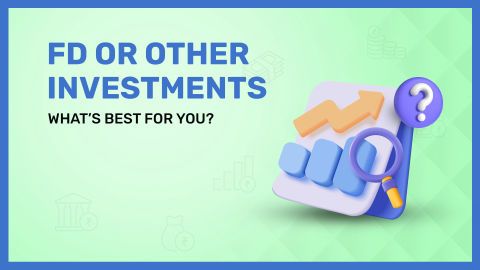A bond fund is an investment vehicle, such as a mutual fund or an exchange-traded fund (ETF), that collects money from multiple investors to invest in a diversified mix of fixed-income instruments like government and corporate bonds. The primary objective of these funds is to deliver regular income to investors. Unlike purchasing single bonds, bond funds provide immediate diversification and are managed by professional fund managers who actively choose and trade bonds to optimise returns and control risk.
The specific bonds held within a fund will exhibit varying levels of risk, return, duration, volatility, and other key characteristics.
In this article, we are going to explore the bond funds eaning, the different types of funds that you can invest in and the various bond fund benefits and risks they pose.
What is bond fund?
A bond fund, also referred to as an income fund, is a collective investment vehicle that pools investor capital to invest in fixed-income securities. The primary objective of a bond fund is to generate a steady income stream for investors through investments in government securities, corporate bonds, debentures, and fixed deposits. These funds are typically offered by mutual fund companies, unit-linked insurance plans (ULIPs), and other financial institutions.
Bond funds can be categorised based on their investment strategy and maturity profile:
- Short-term bond funds: These funds are suitable for investors with a short-term investment horizon of less than a year. They primarily invest in fixed-income securities with shorter maturities.
- Medium to long-term bond funds: Ideal for investors seeking a longer-term investment horizon of at least three years, these funds invest in securities with medium to long maturities.
- Government securities (Gilt) funds: These funds exclusively invest in government bonds, providing a relatively stable and low-risk income stream.
- Dynamic bond funds: These funds actively manage their portfolio by investing in bonds with varying maturities to capitalise on market opportunities and potential gains.
How does a bond fund work?
A bond fund is made up of many individual bonds, chosen and managed by a fund manager. Here’s how it usually works:
When a company or government needs money, they issue bonds. For example, a company might raise money for expansion, while a government may use bonds to fund infrastructure projects. Each bond has a fixed life, known as the maturity date, when the issuer repays the original amount (face value) to the investor.
Bonds are sold at face value but can be bought and traded in the open market before maturity. Their prices often move up or down depending on interest rates, inflation, or the performance of the issuer. During the life of a bond, the issuer also pays regular interest, called a coupon, which stays fixed.
Investing directly in bonds can require very large amounts, often out of reach for small investors. Bond funds solve this problem by pooling money from many investors. They generate steady income, making them attractive for those who want regular earnings, like people planning for retirement.
They can also give better returns than bank deposits when inflation and interest rates are low. However, unlike banks, bond funds carry some risk since the value of your investment may go up or down.
Types of bond funds
Knowing the different types of bond mutual funds that are available in India can help you make informed investment decisions. Let us explore a few of the most common types.
- Treasury bonds: Treasury bonds, including Treasury Inflation-Protected Securities (TIPS), are issued by the federal government and are considered the safest bond option due to their lack of credit risk. These bonds typically have a fixed interest rate and maturities ranging from ten to thirty years.
- State and municipal bonds: State and municipal governments issue bonds to fund public projects such as infrastructure, education, and healthcare. These bonds are often tax-exempt and have maturities ranging from one year to several decades.
- Corporate bonds: Corporations and other large businesses issue bonds to raise capital for operations. These bonds carry a higher risk than Treasury bonds due to the creditworthiness of the issuer. Corporate bond maturities and interest rates vary based on the issuer's credit quality and market conditions.
- Bond Exchange-Traded Funds (ETFs): Bond ETFs are investment funds traded on stock exchanges that primarily invest in a diversified portfolio of bonds. They offer investors a convenient and cost-effective way to gain exposure to the bond market.
- High-yield bonds: High-yield bonds, also known as junk bonds, are issued by companies with lower credit ratings and offer higher interest rates to compensate for the increased risk.
- Mortgage-Backed Securities (MBS): MBS are created by pooling together numerous mortgages and issuing bonds backed by the mortgage pool. They generally offer a lower risk profile than corporate bonds due to the steady income stream generated by the underlying mortgages.
- Floating rate bonds: Floating rate bonds have interest rates that adjust periodically based on a reference rate, such as the repo rate set by the Reserve Bank of India. This helps to mitigate interest rate risk as the bond's interest rate moves in line with market rates.
- Zero-coupon bonds: Zero-coupon bonds are issued at a discount to their face value and do not pay periodic interest. Instead, the investor receives the full face value at maturity, which represents the return on the investment.
- Callable bonds: Callable bonds can be redeemed early by the issuer, often resulting in a premium to the investor. This provides the issuer with flexibility but may also lead to reinvestment risk for the bondholder.
- Convertible bonds: Convertible bonds offer investors the option to convert them into common stock of the issuing company. This provides potential for capital appreciation but also exposes the investor to equity market risk.
- Inflation-protected bonds: These bonds are designed to protect investors from the effects of inflation. The principal and interest payments are adjusted periodically based on changes in the consumer price index.
Example
For example, the HDFC Corporate Bond Fund is an open-ended scheme designed for investment horizons of 6-12 months. It aims to generate income and potential capital appreciation by investing primarily in moderately risky corporate bonds. The fund emphasizes a diversified portfolio, with at least 80% of its assets invested in bonds rated AAA or higher. The NIFTY Corporate Bond Fund Index serves as the benchmark for the fund's performance.
Bond Fund Benefits
Bond funds offer a plethora of attractive benefits. Here is a quick overview of some of the key advantages you get to enjoy by investing in them.
- Diversification
Bond funds typically invest in a basket of different debt securities including those issued by governments, public-sector and private companies and money market instruments. Such diversification helps spread risk across different issuers, protecting you from the negative impact of adverse market movements. - Professional management
Bond funds are actively managed by highly experienced professionals with decades of experience in the debt market. The fund managers actively monitor the market, make necessary adjustments to the funds’ portfolios and are constantly on the lookout for new wealth-creation opportunities while managing risk. - Liquidity
Liquidity is another one of the bond fund benefits that you need to be aware of. The units of the fund can be redeemed at any point in time by selling them back to the Asset Management Company (AMC). In the case of certain funds such as bond Exchange-Traded Funds (ETFs), you can liquidate your investment by selling the units on an exchange. - Steady income stream
Bond funds invest in debt securities that provide interest income periodically, which are distributed to you in proportion to your holdings at regular intervals. You could use the interest payments from the funds to supplement your main income source or reinvest them to increase your wealth creation potential.
How to Choose a Bond Fund?
Tips for choosing a bond fund-
- Define your investment goals: Select a fund that aligns with your financial objectives.
- Assess your risk tolerance: choose a fund that suits your comfort level with interest rate and credit risk.
- Review historical performance: Analyze the fund's past performance, but remember that past results are not indicative of future returns.
- Consider fees: Choose a fund with low expense ratios to maximize your returns.
- Research the Fund Manager: Consider the experience and track record of the fund manager.
Who is bond fund suitable for?
For investors seeking long-term financial goals, income funds offer a versatile solution. Whether held independently or as part of a diversified portfolio, they can effectively support objectives such as funding a child's education, accumulating a down payment for a home, or building retirement savings.
Even investors with a higher tolerance for risk, who may primarily allocate their investments to equity funds or individual stocks, can benefit from incorporating bond funds to enhance portfolio diversification.
Why do investors prefer bond funds?
Easier to invest: Bond funds are often chosen because they are simpler to access than buying individual bonds. Investors also benefit from the expertise of professional fund managers.
Liquidity: These funds generally provide good liquidity, though it can vary depending on market demand and the credit quality of the issuing fund house.
Easy accessibility: Investors can buy bond funds for long-term goals directly through fund companies, banks, or brokers. Options include open-end funds, closed-end funds, ETFs, money market funds, or unit investment trusts.
Quick diversification: A bond fund invests in a wide mix of bonds. This reduces risk since poor performance of a few bonds is balanced by others in the pool, keeping returns relatively steady.
Cost efficiency: Instead of multiple charges, investors only pay an annual expense ratio. This covers management, administration, and marketing costs, making it more cost-effective than managing individual bonds.
Performance metrics and analysis of bond funds
When evaluating the performance of bond funds, investors should consider several metrics to assess their suitability and alignment with investment objectives.
Share price: The market value of a bond fund's holdings per share. Fluctuations in share price are influenced by macroeconomic factors such as interest rates, consumer sentiment, and lending conditions.
Yield: The percentage return on a bond fund's share price or net asset value (NAV), including capital gains, dividend income, and interest. This metric is particularly important for income-oriented investors seeking consistent returns.
Tax-equivalent yield: The adjusted yield of a bond fund that accounts for the tax advantages of certain bond types, such as municipal bonds.
Total return: The overall return on a bond fund, considering both changes in share price and income distributions from capital gains, dividends, and interest.
Duration: A measure of a bond fund's sensitivity to interest rate changes. A longer duration indicates greater sensitivity to interest rate fluctuations.
Credit quality: The creditworthiness of a bond fund's holdings, as assessed by credit ratings assigned by rating agencies.
Risk-adjusted performance: The return on a bond fund relative to its risk, measured by comparing the fund's return to its volatility or systematic risk.
Expense ratios: The annual operating costs of a bond fund as a percentage of its average net assets. These costs include management fees, administrative expenses, and other operational charges.
Tax implications for bond mutual funds
There are three scenarios in which an investor may have to pay income taxes on bond or stock fund investments made outside of a tax-deferred account, such as an IRA:
- The fund's dividends are usually taxed at the standard income rate.
- The sale of assets held by the fund could result in capital gains that are subject to either the preferential long-term capital gains rate or the more traditional ordinary income tax rate, depending on how long the assets are held in the fund.
- Regular income tax and the preferential long-term capital gains rate might be applied to gains from selling or exchanging fund shares.
Your interest payments from the fund might be free from taxes not only at the federal level but also at the state and municipal levels if the bonds it holds were issued by the state where you live.
Risks of bond funds
Despite the many benefits, bond funds also have their share of risks. As a potential investor, knowing what they are can help you make informed investment decisions. Explore the risks associated with mutual funds.
- Interest rate risk
Interest rate risk is the risk of the bond losing its value due to changes in the interest rates in the market. Bond prices and interest rates move inversely, meaning that when interest rates rise, bond prices fall and vice versa. Funds consisting of debt instruments with long maturity periods are more susceptible to interest rate risk. - Credit risk
Credit risk is the risk of the bond issuer defaulting on the payment of either the interest, the principal or both. High-yield bond funds are particularly exposed to credit risk due to their investments in lower-rated bonds. - Principal risk
The principal risk is the risk of losing the principal investment due to factors such as interest rate changes, credit quality deterioration or market conditions.
Bond Funds Vs Bonds
Point of Difference |
Bonds |
Bond Funds |
Interest Rate |
Fixed-rate of interest provided if held to maturity and the issuer does not default. |
The exact effective interest rate can be difficult to determine due to the fund's investment strategy. |
Diversification |
Hard to achieve diversification with individual bond purchases. |
Invests in a diversified portfolio of bonds. |
Costs |
Comparatively more expensive to purchase individual bonds. |
Investing in bond funds is generally less expensive. |
Control Over Maturity |
Bonds have a fixed maturity date. |
No specific maturity date; funds can be bought and sold at any time. |
Key Takeaways
- Core investment: Bond funds primarily invest in a diversified portfolio of fixed-income securities, including municipal and corporate bonds.
- Diversification and accessibility: Bond funds offer investors diversification benefits at a low entry cost.
- Interest rate risk: Long-term bonds are generally more sensitive to interest rate fluctuations compared to short-term bonds.
Conclusion
Bond funds offer a convenient way to access the debt market. The various bond fund benefits make them an attractive investment option if you are seeking capital protection and a passive income source. That said, choosing the right mutual fund schemes is crucial to ensure that you meet your financial goals.
When selecting bond funds, remember to evaluate factors such as the current Net Asset Value (NAV), bond yield and total return, among others. You could use the mutual fund compare tool available on the Bajaj Finserv Mutual Fund Platform to help you choose the right option. The platform hosts more than 1,000 different mutual fund schemes across different categories with the option for both lump sum and SIP investments.
Discover the smarter way to grow your wealth by investing in mutual funds through the Bajaj Finserv platform! Enjoy a wide selection of top-performing funds, seamless online transactions, and expert insights to guide your journey. Start today with flexible options tailored to your goals.








